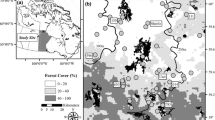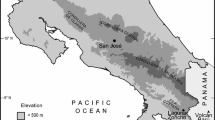Abstract
High-resolution records of geochemical data from four lakes in the Greater Yellowstone region were used to investigate watershed and lake history during the late-glacial and early-Holocene periods. Clastic input to regional lakes was high and variable during the early stages of lake development, when the surrounding landscape was geomorphically unstable and sparsely vegetated, and it decreased as vegetation gradually developed in each catchment. The decrease of clastic input was not regionally synchronous but occurred in a time-transgressive pattern from south to north. Long-term organic matter concentration and diatom production were inversely related to catchment erosion during the early stages of lake development and increased as temperatures warmed and in-lake nutrient concentrations increased. Similarly, calcite production usually was low following lake formation and increased over time, driven by climate change and its associated influences on lake-level, algal production, and lake thermal structure. Overall differences in the timing and pattern of geochemical change indicate that once the landscape had stabilized following deglaciation, changes in the geochemical character of the sediments were strongly influenced by local factors.










Similar content being viewed by others
References
Aguilar C, Nealson KH (1998) Biogeochemical cycling of manganese in Oneida Lake, New York: whole lake studies of manganese. J Gt Lakes Res 24:93–104
Alley RB, Clark PU (1999) The deglaciation of the northern hemisphere: a global perspective. Annu Rev Earth Planet Sci 27:149–182
Battarbee RW (2000) Palaeolimnological approaches to climate change with special regard to the biological record. Quat Sci Rev 19:107–124
Berger AL (1978) Long-term variations of caloric insolation resulting from Earth’s orbital elements. Quat Res 9:139–167
Bigler C, Larocque I, Peglar SM, Birks HJB, Hall RI (2002) Quantitative multi-proxy assessment of long-term patterns of Holocene environmental change from a small lake near Abisko, northern Sweden. Holocene 12:481–496
Bigler C, Grahn E, Larocque I, Jeziorski A, Hall R (2003) Holocene environmental change at Lake Njulla (999 m asl), northern Sweden: a comparison with four small nearby lakes along an altitudinal gradient. J Paleolimnol 29:13–29
Birks HH, Battarbee RW, Birks HJB (2000) The development of the aquatic ecosystem at Krakenes Lake, western Norway, during the late-glacial and early-Holocene—a synthesis. J Paleolimnol 23:91–114
Blaauw M, Christen A (2011) Flexible paleoclimate age-depth models using an autoregressive gamma process. Bayesian Anal 6:457–474
Bradshaw EG, Jones VJ, Birks HJB, Birks HH (2000) Diatom responses to late-glacial and early-Holocene environmental changes at Kråkenes, western Norway. J Paleolimnol 23:21–34
Brown ET (2015) Estimation of biogenic silica concentrations using scanning XRF: insights from studies of Lake Malawi sediments. In: Croudace IW, Rothwell RG (eds) Micro-XRF studies of sediment cores-applications of a non-destructive tool for the environmental sciences. Developments in paleoenvironmental research, vol 17. Springer, Dordrecht, pp 267–277
Cohen AS (2003) Paleolimnology: the history and evolution of lake systems. Oxford University Press, New York
Croudace IW, Rothwell RG (eds) (2015) Micro-XRF studies of sediment cores—applications of a non-destructive tool for the environmental sciences. Developments in paleoenvironmental research, vol 17. Springer, Dordrecht, p 656
Croudace IW, Rindby A, Rothwell RG (2006) ITRAX: description of evaluation of a new multi-functional X-ray core scanner. In: Rothwell RG (ed) New techniques in sediment core analysis. The Geological Society of London, London
Das BK, Haake B-G (2003) Geochemistry of Rewalsar Lake sediment, Lesser Himalaya, India: implications for source-area weathering, provenance and tectonic setting. Geosci J 7:299–312
Das SK, Routh J, Roychoudhury AN, Klump JV, Ranjan RK (2009) Phosphorus dynamics in shallow eutrophic lakes: an example from Zeekoevlei, South Africa. Hydrobiologia 619:55–66
Davison W (1993) Iron and manganese in lakes. Earth Sci Rev 34:119–163
Dean WE, Megard RO (1993) Environment of deposition of CaCO3 in Elk Lake, Minnesota. In: Bradbury JP, Dean WE (eds) Elk Lake, Minnesota: evidence for rapid climate change in the North-Central United States. Geological Society of America, Boulder, Special Paper 276, pp 97–114
Engstrom DR, Fritz SC, Almendinger JE, Juggins S (2000) Chemical and biological trends during lake evolution in recently deglaciated terrain. Nature 408:161–166
Fritz SC, Anderson NJ (2013) The relative influences of climate and catchment processes on Holocene lake development in glaciated regions. J Paleolimnol 49:349–362
Grimm EC, Donovan JJ, Brown KJ (2011) A high-resolution mineral, pollen, and charcoal record of climatic variability and landscape response from Kettle Lake in the Northern Great Plains of North America. Quat Sci Rev 30:2626–2650
Hammer Ø, Harper DAT, Ryan PD (2001) PAST: paleontological statistics software package for education and data analysis. Palaeontol Electron 4:9
Higuera PE, Brubaker LB, Anderson PM, Brown TA, Kennedy AT, Hu FS (2008) Frequent fires in ancient shrub tundra: implication of paleo-records for arctic environmental change. PLoS ONE 3:e0001744
Hobbs WO, Fritz SC, Stone JR, Donovan JJ, Grimm EC, Almendinger JE (2011) Environmental history of a closed-basin lake in the US Great Plains: diatom response to variations in groundwater flow regimes over the last 8500 cal yr BP. Holocene 21:1203–1216
Jacobs K, Whitlock C (2008) A 2000-year environmental history of Jackson Hole, Wyoming, inferred from lake-sediment records. West N Am Nat 68:350–364
Jin Z, Li F, Cao J, Wang S, Yu J (2006) Geochemistry of Daihai Lake sediments, Inner Mongolia, north China: implications for provenance, sedimentary sorting, and catchment weathering. Geomorphology 80:147–163
Koinig KA, Shotyk W, Lotter AF, Ohlendorf C, Sturm M (2003) 9000 years of geochemical evolution of lithogenic major and trace elements in the sediment of an alpine lake: the role of climate, vegetation, and land-use history. J Paleolimnol 30:307–320
Krause TR, Whitlock C (2013) Climate and vegetation change during the late-glacial/early-Holocene transition inferred from multiple proxy records from Blacktail Pond, Yellowstone National Park, USA. Quat Res 79:391–402
Krause TR, Lu Y, Whitlock C, Fritz S, Pierce KL (2015) Patterns of terrestrial and limnologic development in the northern Greater Yellowstone Ecosystem (USA) during the late-glacial/early-Holocene transition. Palaeogeogr Palaeoclimatol Palaeoecol 422:46–56
Kuehn SC, Froese DG, Carrara PE, Foit F, Pearce NJG, Rotheisler P (2009) Major and trace-element characterization, expanded distribution, and a new chronology for the latest Pleistocene Glacier Peak tephras in western North America. Quat Res 71:201–216
Kylander ME, Ampel L, Wohlfarth B, Veres D (2011) High-resolution X-ray fluorescence core scanning analysis of Les Echets (France) sedimentary sequence: new insights from chemical proxies. J Quat Sci 26:109–117
Licciardi JM, Pierce KL (2008) Cosmogenic exposure-age chronologies of Pinedale and Bull Lake glaciations in greater Yellowstone and the Teton Range, USA. Quat Sci Rev 27:814–831
Licciardi JM, Clark PU, Brook EJ, Elmore D, Sharma P (2004) Variable responses of western US glaciers during the last deglaciation. Geology 32:81–84
Lu Y (2014) Watershed and aquatic ecosystem evolution during the late-glacial and early-holocene inferred from high-resolution diatom and geochemical records in the Yellowstone Region. Ph.D. Thesis, University of Nebraska-Lincoln
Meyers PA, Teranes JL (2001) Sediment organic matter. In: Last WM, Smol JP (eds) Tracking environmental change using lake sediments, vol 2. Physical and geochemical methods. Kluwer Academic Publishers, Dordrecht, pp 239–269
Moreno A, Giralt S, Valero-Garces B, Saezc A, Baod R, Pregoe R, Pueyoc JJ, Gonzalez-Samperiza L, Tabernerb C (2007) A 14 kyr record of the tropical Andes: the Lago Chungará sequence (18°S, northern Chilean Altiplano). Quat Int 161:4–21
Morgan LA, Shanks WC III, Pierce KL (2009) Hydrothermal processes above a large magma chamber: large hydrothermal systems and hydrothermal explosions in Yellowstone National Park. Geol Soc Am Spec Pap 459:1–95
Peinerud EK (2000) Interpretation of Si concentrations in lake sediments: three case studies. Environ Geol 40:64–72
Pierce KL (1979) History and dynamics of glaciations in the northern Yellowstone National Park area. US Geol Surv Prof Pap 729F:91
Pierce KL (2004) Pleistocene glaciations of the Rocky Mountains. In: Gillespie A, Porter SC (eds) Developments in quaternary science, vol 1. Elsevier, Amsterdam, pp 63–76
Pierce KL, Good JM (1990) Quaternary geology of Jackson Hole, Wyoming. In: Roberts SM (ed) Geologic field tours of western Wyoming and parts of adjacent Idaho, Montana, and Utah. Public Information Circular, number 29, Geological Survey of Wyoming, Laramie, Wyoming, USA, pp 127–138
Reimer PJ, Bard E, Bayliss A, Beck JW, Blackwell PG, Ramsey CB, Buck CE, Cheng H, Edwards RL, Friedrich M, Grootes PM, Guilderson TP, Haflidason H, Hajdas I, Hatté C, Heaton TJ, Hoffmann DL, Hogg AG, Hughen KA, Kaiser KF, Kromer B, Manning SW, Niu M, Reimer RW, Richards DA, Scott EM, Southon JR, Staff RA, Turney CSM, van der Plicht J (2013) IntCal13 and Marine13 radiocarbon age calibration curves 0–50,000 years cal BP. Radiocarbon 55:1869–1887
Saros JE, Anderson NJ (2015) The ecology of the planktonic diatom Cyclotella and its implications for global environmental change studies. Biol Rev 90:522–541
Shakun JD, Carlson AD (2010) A global perspective on Late Glacial Maximum to Holocene climate change. Quat Sci Rev 29:1801–1816
Thackray GD (2008) Varied climatic and topographic influences on Late Pleistocene glaciation in the western United States. J Quat Sci 23:671–681
Waddington JCB, Wright HE Jr (1974) Late Quaternary vegetational changes on the east side of Yellowstone Park, Wyoming. Quat Res 4:175–184
Westover KS, Fritz SC, Blyakharchuk TA, Wright HE Jr (2006) Diatom paleolimnological record of environmental change in the Altai Mountains, Siberia. J Paleolimnol 35:519–541
Wetzel RG (2001) Limnology of lake and river ecosystems, 3rd edn. Academic Press, San Diego
Whitlock C (1993) Postglacial vegetation and climate of Grand Teton and southern Yellowstone National Parks. Ecol Monogr 63:173–198
Whitlock C, Bartlein PJ (1993) Spatial variations of Holocene climatic change in the Yellowstone region. Quat Res 39:231–238
Whitlock C, Dean WE, Fritz SC, Stevens LR, Stone JR, Power MJ, Rosenbaum JR, Pierce KL, Bracht-Flyr BB (2012) Holocene seasonal variability inferred from multiple proxy records from Crevice Lake, Yellowstone National Park, USA. Palaeogeogr Palaeoclimatol Palaeoecol 331–332:90–103
Wright HE Jr, Mann DH, Glaser PH (1983) Piston corers for peat and lake sediments. Ecology 65:657–659
Zeeb BA, Smol JP (2001) Chrysophyte scales and cysts. In: Smol JP, Birks HJB, Last WM (eds) Tracking environmental change using lake sediments. Algal and siliceous indicators, vol 3. Terrestrial. Kluwer Academic Publishers, Dordrecht, pp 203–223
Acknowledgements
This research was supported by National Science Foundation Grants EAR-0816576 to S. Fritz and EAR-0818467 to C. Whitlock, as well as a GSA Graduate Student Research grant to Y. Lu. We thank C. Hendrix and S. Gunther (Yellowstone National Park) for logistical support, and T. Spanbauer, D. Navarro, and J. Giskaas for field assistance.
Author information
Authors and Affiliations
Corresponding author
Rights and permissions
About this article
Cite this article
Lu, Y., Fritz, S.C., Stone, J.R. et al. Trends in catchment processes and lake evolution during the late-glacial and early- to mid-Holocene inferred from high-resolution XRF data in the Yellowstone region. J Paleolimnol 58, 551–569 (2017). https://doi.org/10.1007/s10933-017-9991-x
Received:
Accepted:
Published:
Issue Date:
DOI: https://doi.org/10.1007/s10933-017-9991-x




